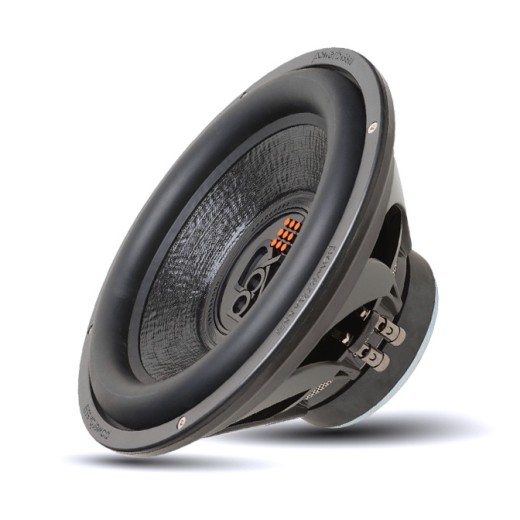Subwoofer Powerbass XL-1244D
12", 400/800 W, 86.78 dB (SPL 1 W/1 m), 2 x 4 Ω
More about the product
More about the product
Subwoofer Powerbass XL-1244D
The newly designed Powerbass XL Series subwoofers feature the same great looks and performance you're used to, but now optimized for an extended low-frequency response that gives you even better sound at the low end of the frequency range and increases the overall sound quality of your bass tones. Boasting a custom turbine-style polycarbonate/fiberglass frame, the unique basket holds magnets with dual trays and an extended dome back plate. It uses a combination of circumferential and pole venting to keep air circulating through the voice coil so everything stays cool enough. The unpressed paper diaphragm was chosen for naturally smooth bass reproduction with the ability to deliver high performance with low distortion. Finally, to make sure the power goes to the subwoofer, we used chrome connectors in the Powerbass for maximum current transfer. The XL Series subwoofers are extremely versatile and deliver amazingly low bass whether installed in a small closed cabinet or a bass reflex cabinet, and are available in 8”, 10” and 12”.Main features of the Powerbass XL-1244D subwoofer
- 12" subwoofer with a power of 400 W RMS.
- Double oscillating coil with an impedance of 4 + 4 Ω.
- New wide Santoprene® curtain.
- Diaphragm made from proprietary DDC Coated Cone paper.
- 51mm vented BASV voice coil.
- Perimeter vents for Aero-Vent voice coil cooling.
- Custom non-resonant polycarbonate/fiberglass basket.
- Chrome connection terminals.
- Optimally designed for small closed or bass reflex cabinets.
About the Powerbass brand
Powerbass was founded in 2001 with one goal in mind: to bring to the market great audio products offering perfect sound and high reliability at an affordable price. Powerbass is headquartered in Ontario, California, where it also owns manufacturing facilities with a top engineering team and development management. Originally, Powerbass focused on the production of high-quality OEM speakers, which at the time represented inimitable quality in the given price category. Over the years, they have expanded the offer with many products such as subwoofers or amplifiers and of course several model series of speakers, of which the basic "S" series in particular has become almost legendary. And always with the same goal as in the beginning - to offer affordable products that surpass the competition. Two decades later, Powerbass honors the same values and offers its customers a comprehensive portfolio of high-quality products to maximize the music listening experience.| Catalog number | XL-1244D |
| Brand | Power bass |
| Links | Official web presentation (English) |
| RMS powerThe RMS power of the subwoofer is the constant power of continuous use of the subwoofer. If the power is exceeded for a longer period of time, irreversible damage may occur, or to burn out the voice coil of the subwoofer. | 400 W |
| Max. (maximum performancePeak performance , which the subwoofer can play momentarily (approx. 0.5 s), for example when hitting drums in a song. If the maximum power is exceeded, damage can quickly occur, or to burn out the voice coil of the subwoofer. | 800W |
| Sensitivity (SPL 1W/1m)Subwoofer sensitivity or efficiency. The sensitivity of the subwoofer is given in decibels (dB) and, in simple terms, means that the higher the value, the lower the demands on the power of the amplifier. This is a de facto rating of how a subwoofer converts watts to sound. Sensitivity ratings are in noise level measured at 1 meter from the subwoofer using 1 W (watt of power) or using 2.83 volts at the source at 1 meter. A higher decibel level means the subwoofer is louder with less power. For every 3 dB increase in sensitivity, the subwoofer requires half the power to reproduce the same volume. For example, if an 88 dB subwoofer needs 300 watts to produce a certain volume, then a 91 dB subwoofer needs only 150 watts to reach the same efficiency. | 86.78 dB |
| ImpedanceImpedance - measurement of electrical resistance. When buying a subwoofer, it is very important that everyone make sure that the impedance matches the amplifier that you are connecting to it. For subwoofers with a double voice coil, we recommend following the information in the advice center! Example: A 2 Ohm subwoofer cannot be connected to an amplifier that is only stable up to 4 Ohms. A 4 Ohm subwoofer can easily be used on an amplifier that is stable up to 2 Ohms. Connecting a 4 Ohm subwoofer to an amplifier that is stable up to 4 Ohms also without problems. The most common subwoofer impedance is 4 Ohm. | 2 x 4 Ω |
| Frequency rangeThe ability of the subwoofer to play a signal from the lowest frequency to the highest, or the ability of a subwoofer to faithfully reproduce sound in a specific frequency band. Subwoofers ideally play from 20 - 150 Hz. Professionally: In the frequency range from 40 to 16,000 Hz, the vast majority of fundamental and overtones (harmonics) of all musical instruments are found. We are interested in the course of the radiated sound pressure in this range of frequencies when the loudspeaker system is supplied with constant power. We call this course the frequency characteristic, which tells us the level of radiated sound pressure in decibels (dB) depending on the frequency. The frequency characteristic of a speaker or speaker system can be expressed most succinctly with a graph. Mostly, however, the frequency characteristic is indicated by indicating the maximum tolerance of the sound pressure in the given frequency range, e.g. 50 to 15,000 Hz -+ 6 dB. Since the frequency characteristics of loudspeakers and systems in general are quite uneven, some manufacturers do not even indicate this maximum tolerance of sound pressure in decibels in their catalogs for tactical reasons. Data impoverished in this way is unfortunately worthless. What is valid is that the manufacturer offers a speaker system with a frequency range of 30 to 20,000 Hz, if he is worried about stating the maximum unevenness of the sound pressure in this range, because he can have a tolerance of, for example, +- 20 dB. The unevenness or undulation of the frequency curve in good speaker systems for high-quality music performance should not exceed +-3 dB in the 80 to 12,000 Hz band and +-6 dB in the 40 to 16,000 Hz band. Greater unevenness already depletes or emphasizes certain tonal areas, which can cause audible or even disturbing distortion. The proportion between fundamental tones and higher harmonics also changes, thereby changing the color of the sound, and individual musical instruments as well as the entire musical image sound unnatural. | 26 - 300 Hz |
| Subwoofer diameterThe diameter of the subwoofer is indicated on the screw holes. The overall outer diameter of the subwoofer is usually 1-2 cm wider, depending on the size category of the subwoofer. For a 30 cm subwoofer, the outer diameter incl. protective rubber 31.8 cm and in the 25 cm subwoofer it is 26.5 cm incl. protective rubbers. | 300mm (12") |
| Subwoofer mounting depthThe mounting depth of the subwoofer is measured from the bottom edge of the magnet to the bottom edge of the subwoofer's metal or cast basket. | 144 mm |
| Fs - resonant frequencyFs - is the lower resonant frequency. This parameter is the de facto free air resonant frequency of the subwoofer. Simply put, it is the point at which the weight of the subwoofer's moving parts equals the force of the subwoofer's suspension while it is in motion. If you've ever seen a piece of string start to hum uncontrollably in the wind, you've seen the effect of reaching a resonant frequency. The weight of the moving parts and the stiffness of the suspension (surround and spider) are key elements that affect the resonant frequency. As a general rule, a lower Fs indicates a subwoofer that would be better at reproducing low frequencies than a subwoofer with a higher Fs. However, this is not always the case, as other important parameters of the subwoofer also enter the resulting sound. | 27.5 Hz |
| Vas - equivalent volume of airVas - represents the volume of air that, when compressed per cubic meter, acts with the same force as compliance (CMS), suspension in a certain subwoofer. Vas is one of the most complicated parameters to measure, as changes in air pressure are affected by conditions of relative humidity and temperature. Another way to describe what VAS is: try using a subwoofer and find a baffle that is the right size to return the air with the same stiffness to the same resonance. The size of this box is equal to you. There are, of course, other parameters, but they are not so necessary for the exact calculation of the enclosure. Resonance frequency and Q-parameter values are also important when building enclosures. | 66.37 l |
| Xmax + -Xmax - the maximum deflection of the subwoofer diaphragm in one direction – it is not a sum, or an abbreviation for the maximum linear deflection. The subwoofer output becomes non-linear as the voice coil begins to leave the magnetic gap. | 8 mm |
| QesElectrical Q-factor of driver is the electrical quality factor (electrical damping). If the subwoofer coil moves in a magnetic field, it generates its own current that counteracts its movement. Qes is a dimensionless parameter and the lower the number, the higher the generated current and the more damped the coil movement, thus reducing the total current flowing through the coil, the deflection and the sensitivity around the fs resonance. It varies in values from 0.08 to 0.6, in the extremes, for ordinary universal converters, even 20. Subwoofers with too low a Qes value, a very damped system, are not suitable for certain types of enclosures. | 0.462 |
| QmsMechanical Q-factor of driver is a mechanical factor of quality (mechanical damping). These are mechanical losses affecting (damping) the movement of the subwoofer membrane. Qms is a dimensionless parameter and the higher the number, the smaller the losses, i.e. the deviation and sensitivity in the lower band is also higher, it ranges around 0.4 - 25. | 4,794 |
| QtsTotal Q-factor of driver is a total quality factor, it includes both parameters Qes and Qms (electrical Qes and mechanical Qms). It varies in values from approx. 0.08 to 0.6, exceptionally up to 3. The Qts of the subwoofer is calculated in the same way as, for example, a pair of parallel resistors, so the result is decisively influenced by a smaller value that cannot be exceeded, which is usually Qes. | 0.421 |
| Subwoofer voice coil diameterThe larger the diameter of the voice coil, the more load capacity the subwoofer has, in layman's terms. | 51 mm |
| Subwoofer diaphragm materialThe specific material from which the subwoofer membrane is made. | Paper |
Product comments
Evaluation
ask us
























